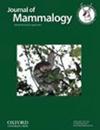岛屿面积和饮食可预测西北太平洋群岛蝙蝠的多样性和分布情况
IF 1.6
3区 生物学
Q2 ZOOLOGY
引用次数: 0
摘要
岛屿生物地理学理论预测,岛屿和类岛系统中物种的丰富性是岛屿隔离和面积的最终结果。据预测,具有高扩散能力的物种受这些因素的影响较小,因为它们有能力在岛屿或栖息地之间更有效地移动,在此我们以蝙蝠--唯一具有飞行能力的哺乳动物--来验证这一观点。我们在圣胡安群岛(美国华盛顿州)和邻近的西北大陆的 21 个岛屿上进行了雾网和声学调查,目的是(i) 调查岛屿面积、与大陆的距离和栖息地对蝙蝠多样性的影响;(ii) 评估物种间形态(体重、前臂长度、翼负荷)和生态(食物生态位广度、觅食行业)特征的差异是否会影响它们在岛屿间的分布。我们发现,岛屿大小对物种丰富度模式有很大影响,岛屿越大,蝙蝠物种越多。然而,在本研究中,岛屿与大陆的距离以及栖息地的可用性都不是物种丰富度的重要预测因素。此外,我们还发现,与任何形态特征相比,食物生态位的广度最能预测各岛屿物种的普遍性。我们的研究结果表明,食性更专一的物种可能更容易受到栖息地破碎化的影响,这也让我们了解到地理和生态因素是如何影响海岛蝙蝠群落的多样性的,同时也让我们进一步了解到物种特征在物种对大规模景观结构的反应中所起的中介作用。本文章由计算机程序翻译,如有差异,请以英文原文为准。
Island area and diet predict diversity and distribution of bats in a Pacific Northwest archipelago
The island biogeography theory predicts that species richness in islands and island-like systems is the ultimate result of island isolation and area. Species with high dispersal capabilities are predicted to be less affected by these factors because of their capacity to move more efficiently between islands or habitats, and here we test this idea in bats, the only mammals capable of flight. We conducted mist net and acoustic surveys across 21 islands in the San Juan Archipelago (Washington State, United States) and adjacent northwest mainland to: (i) investigate the effects of island area, distance from mainland, and habitat on bat diversity; and (ii) evaluate whether differences in morphological (body mass, forearm length, wing loading) and ecological (dietary niche breadth, foraging guild) traits among species influence their prevalence across islands. We found that island size strongly influenced patterns of species richness, with larger islands having a greater number of bat species. However, neither island distance from mainland nor any measure of habitat availability was a significant predictor of species richness at the scale of this study. Additionally, we found that dietary niche breadth, as opposed to any morphological trait, best predicted the prevalence of species across the islands. Our results suggest that species with more specialized diets may be more vulnerable to habitat fragmentation, and provide insight into how geographic and ecological factors affect the diversity of insular bat communities, adding to growing knowledge about the role of species traits as mediators of their responses to large-scale landscape structure.
求助全文
通过发布文献求助,成功后即可免费获取论文全文。
去求助
来源期刊

Journal of Mammalogy
生物-动物学
CiteScore
3.30
自引率
5.90%
发文量
106
审稿时长
4-8 weeks
期刊介绍:
Papers are published on mammalian behavior, conservation, ecology, genetics, morphology, physiology, and taxonomy.
 求助内容:
求助内容: 应助结果提醒方式:
应助结果提醒方式:


